Images of the Virgin Mary are for sale in various sizes and materials. From stunning handcrafted wood carvings to pulpwood or tree resin images.
The description of the statues of the Virgin Mary tells us if that image is for sale in different sizes. For example, one of our Spanish handmade Our Lady of Mount Carmel figurine is for sale in 60, 80, 100, 120, 140 and 160 cm. In the card of this image of the Virgen del Carmen there is a dropdown in which you can consult the sale price of each of the measures.
There is a wide variety of materials in which an image of the Virgin Mary can be made. In Religious Articles Brabander we are specialized in Olot religious images. Christian art pieces made of pulp wood with glass eyes. All the imagery works of Olot of the Virgin Mary are made following the same artisan process that was used more than a century ago. The pieces of imagery of the Virgin from the Olot workshops are grouped in the "Pasta Madera" filter.
In addition to the religious images of Olot, there are other statues of the Virgin Mary made of other materials: marble, resin, etc... We have grouped all these images under the name "Economic Series".
The Virgin Mary, the young woman known as Mary of Nazareth, is one of the most important people in the life of Jesus and of all faithful Catholics. Its importance from its very conception and extends until its ascent to the Kingdom of Heaven. An earthly life and a heavenly life dedicated to Jesus, to announce the Word of God and to protect all humanity. From his birth, from his very conception we could say, he forgot his personal motivations and gave his life to the service of God.
The Immaculate Conception of Mary is a dogma approved by the Catholic Church in which it is recognized that the Virgin Mary, unlike other human beings as the future mother of Christ, was not affected by original sin. The Most Pure conception of the Blessed Virgin Mary in the womb of her mother, Saint Anne, was free from all sin, any stain or effect of original sin from the first moment. The Blessed Virgin Mary, as the future mother of Jesus, from this first moment was granted grace before original sin could stain her soul.
The dogma of the Immaculate Conception is summed up in the expression "full of grace" (Gratia Plena) that we pronounce every time we recite the Hail Mary.
Many saints and scholars have written about the Immaculate Conception of Mary, such as Saint Anthony of Padua,
The childhood and youth of the Virgin Mary
The Mother of God was raised in a family that deeply believes in the Word of the Lord. His parents, San Joaquín and Santa Ana, were faithful followers of the words of Moses and the prophets. The Holy Mother of the Church, Queen of Heaven and Earth, was linked to the activity of the temples from her earliest childhood.
Like all boys and girls, she was presented in the temple almost newborn. As soon as he was able, he began to serve in the temple in Jerusalem. After several years of servitude, the time came when she should marry. Zacarías was in charge of selecting the man who would be her future husband. The chosen one was Saint Joseph.
Shortly after their engagement, which was blessed by God, they became husband and wife.
"Rejoice, full of grace, the Lord is with you" this is the phrase with which the Angel Gabriel greeted the Virgin Mary one of the most important days for all humanity. On that day, popularly known as the Annunciation, the Angel Gabriel appeared to the Most Holy Virgin Mary that in her womb Emmanuel, Jesus, who would be the "Son of the Most High and the Lord God will give him the throne of David, his dad; He will reign over the house of Jacob forever, and his kingdom will have no end.”
After centuries of darkness, humanity can hope again, the prophecies will be fulfilled. The Virgin Mary will carry out the mission with which God had created her, to be the Mother of the Son of God, the Savior of humanity.
The Holy Spirit was going to beget Jesus miraculously in the virginal womb of Our Lady. The arrival of the Messiah was near. The Lamb of God would come to the world to give his life for the forgiveness of the sins of all Christians.
The Virgin is the Mother of Jesus Christ , she is the person who carried him in her womb for nine months before giving birth to our Savior in a small manger in Bethlehem. It was also one of his main supports throughout the life of Christ.
During the childhood years she was a loving and protective mother who tried to give her son the best. The Virgin Mary, the Tower of David, knew that her son was going to be very special to the whole world and tried to educate him with much love.
When Jesus began his public life, a time full of miracles and teachings, the Most Holy Mary was his support and confidant. One of the props, along with the Apostles, on which Christ stood during his intense evangelizing work.
Mary of Nazareth was chosen by God to be the mother of her son our Lord Jesus Christ. The life of the Virgin is totally linked to that of Jesus. Christ became flesh to show us the path we should follow to reach the Kingdom of Heaven through the Resurrection. Jesus became a man to defeat death and be our guide to eternal life.
The path that Jesus had to travel was full of sacrifices until he reached the highest offering, giving his life for all of us. Throughout her life she had the company of the Virgin, the Ivory Tower, who suffered with each of the steps that throughout her life brought her Son closer to the Cross. Although the Mother of God was full of faith, seeing Jesus suffer caused her great pain and suffering. Traditionally, seven fundamental ailments are highlighted throughout the life of the Virgin Mary.
The Virgin Mary and Saint Joseph, in order to comply with the provisions of the Law of Moses, had to reach the Child Jesus at the temple to present him before God.
In the temple there was an old man who everyone knew as Simeon. He was a kind, wise and faith-filled man who was respected by all. Simeon had had the revelation that, before he died, he would meet the Messiah, the true Son of God.
When Simeon found Jesus with his parents he quickly recognized him, that child would be the one who would inherit the Throne of David. He showered the child and his parents with blessings.
Before saying goodbye, Simeón told Santa María that he would be the one announced in the prophecies, but reaching the place that corresponded to him “will be a sword for yourself that will pierce your soul.” At that moment, Saint Mary knew the sacrifice and the pain that her Son and herself would bear to save the people who deserved it.
After the visit of the Magi to the manger in Bethlehem where the Savior had been born, an Angel appeared. The angelic entity came to warn the Three Wise Men not to return to Herod's castle as they had agreed with the monarch. Herod's intentions were dishonest and he wanted to know the place where the Messiah was born in order to assassinate him.
The king soon discovered that the Kings of the East would not give him any information. Therefore, since he did not know the exact place of Jesus' birth, he gave the order to kill all those under two years of age in Bethlehem.
Saint Joseph, in a dream, was visited by an Angel who told him to take his wife and son. He was to leave immediately for Egypt where he would remain hidden. Saint Joseph quickly obeyed, his faith saving his son's life.
The Virgin felt great pain when starting the trip. The outward journey from Bethlehem to Egypt was very hard for anyone, much more so for a newborn. He felt a great pain in his heart but he knew that it was the only way to keep Jesus alive.
Saint Joseph, the Virgin Mary and the Child visited Jerusalem to celebrate the Easter festivities. One year, when Jesus was almost a teenager, Saint Joseph and Saint Mary, after the end of Easter, collected their belongings and began the journey towards their case. Both were convinced that Jesus Christ was inside the caravan.
When they arrived at their house they discovered that Jesus was not there. Both began to search for the boy intensely. They were deeply scared. They visited every meadow, knocked on every door of relatives and neighbors, looked into every forest. There were millions of spaces and places where the child could be. After three days of desperate searching, and after receiving no news of their son's whereabouts, they decided to return to Jerusalem again.
When they got back to the temple they found Jesus talking to the wise men. Everyone was amazed at the child's culture. At his young age it seemed like an encyclopedia of knowledge, it was learning about great truths collected in ancient books. Happiness and joy flooded the hearts of the parents to find their son safe and sound.
The fourth pain that history associates with Our Lady the Virgin Mary is the first of them that is linked to the adult life of Christ. Until this moment, all the sufferings that Mary goes through have to do with events from the childhood and adolescence of Jesus. The fourth pain is located in the final stretch of the earthly life of Jesus Christ. His path is marked, he has been sentenced to die on the Cross. The Way of the Cross and the Crucifixion on Mount Golgotha (Mount Calvary) will be the beginning of his journey to heaven.
The Incarnate Word suffers an authentic martyrdom after the death sentence pronounced by Pontius Pilate. First, the crown of thorns is put on him, which damages his head, and then he scourges with derision, which destroys his body. Jesus meets the Virgin after his first fall. The weight of the Cross becomes heavier and heavier and the Nazarene's strength fails him.
The eyes of mother and son meet. The Virgin Mary can hardly stand the pain that her heart takes. His beloved son, the Savior, determinedly walks towards his death passing through innumerable humiliations and pains.
The meeting of Christ and his mother on the way to Golgotha is remembered in the fourth station of the Via Crucis.
Once the Via Crucis was finished, the Savior, badly wounded, was crucified on the Cross that he had carried on his back. To the intense pain that the nails that tortured him on the Cross produced, we had to add the innumerable insults that heartless people who passed by said to him. The teasing was a constant.
At the foot of the Cross of Jesus, always faithful, were the Virgin Mary, Saint John, Mary wife of Cleophas (his mother's sister) and Mary Magdalene. The four tried to help in what they could to mitigate the suffering of the Redeemer.
Just before giving his spirit to God, Jesus said to Saint Mary "Woman, there you have your son". Looking at Saint John, he said "There you have your Mother". Christ knew that his earthly death was near, but before leaving this world he wanted to leave a message to his Holy Mother. Saint Mary was to become the mother of Saint John, and, by extension, the mother of all Christ's followers. Our Lady Mary, from that moment on, should not bear sorrow or resentment for the loss of Jesus, but rather should become the mother of all Christians in the world.
At the same time, with the message he gave to Saint John, Christ tells his disciple that he must love the Celestial Queen as a mother. All Catholics must love Mary as a mother. The followers of Christ must have the Miraculous Virgin as a guide to reach the Kingdom of Heaven.
The passage of Christ's death is commemorated every Holy Week on Good Friday. The figure of Christ dead on the Cross is one of the religious images that arouses the greatest devotion and respect among believers throughout the national territory.
The Nazarene has died, the Redeemer has fulfilled the prophecies and has given his spirit to the Holy Father. The lifeless Body of Jesus remains nailed to the Cross but will soon be lowered to deliver it to his relatives and followers.
Joseph of Arimathea, an illustrious member of the Sanhedrin, who had witnessed the greatness of the Word of God, was in charge of requesting the body of Christ for burial.
The pain of the Holy Mother was indescribable, she had seen how her son, the Savior, had died in terrible suffering. The only consolation he had was the words of Jesus and his unwavering faith.
The sixth pain of Saint Mary has been reproduced throughout the history of humanity in innumerable sculptures, statues, paintings, ... Such has been the number of artistic works that have reflected these facts that they receive two names that identify this passage known to members of all religions.
The first of these appellations is the Descent (or the Descent from the Cross). The sculptural or pictorial pieces that are known by this name are reproductions of the moment in which Christ, already dead, is freed from the nails that keep him on the Cross. It is a moment of great symbolic charge since, in some way, Christ has made the greatest sacrifice for all sinners and sinners, he has given his life to save humanity. The religious images of this event reflect the sadness of those present before the lifeless body of Jesus Christ.
The second of the two designations is Pietà . The sculptural ensembles or canvases known by the name of Pietà are reproductions of the moment in which the body of Christ is delivered to Santa María. The Virgin, shattered inside, holds the lifeless body of her beloved son in her arms. Religious images of piety have become the universal symbol of a mother's love for her children.
Our Lady said goodbye to her son and let him be taken away to be prepared for burial. According to what the book of the Bible tells us, the body of Christ was prepared by Joseph of Arimathea and Nicodemus. Between the two of them they used myrrh, scented substances and bandages to prepare the body so that it could rest in the grave.
Jesus only remained in the tomb for three days. On the third of those days he rose from the dead to defeat death and open the doors of eternal life to all Catholics. The books of the Gospels do not specify whether the Virgin Mary received a visit from the Risen Christ. Marianologists and scholars of the books of the Gospels do not agree on this point. However, despite the fact that there is no reference in the Bible, it is to be assumed that Jesus, after his Passion and Resurrection, had his mother as a mandatory visit. Popular culture has made a clear statement in this regard. It is a tradition in most Holy Week celebrations that on Easter Sunday, the image of the Risen Christ meets the image of Saint Mary . Both figures, in a beautiful reunion, are the pillars on which the Catholic Church has stood firm in recent centuries.
After the Death, Passion and Resurrection of Christ, the Virgin Mary, as requested, went to live with Saint John. According to some scholars, he also shared living with some of the other Apostles. In any case, what does seem clear is that they lived hidden, clandestinely, avoiding the Roman legions that persecuted them for being followers of Jesus.
During this time the Apostles, determined to spread the word of the Lord throughout the world, traveled the length and breadth of the known land. The Virgin Mary blessed all of them and encouraged them to fulfill the will of her son. In this sense, the support that Santiago the Elder received in his evangelization at the End of the World is especially noteworthy. The Apostle Santiago was losing faith in the face of the little success of his words among the natives of the territories that today form the Iberian Peninsula. The Miraculous Virgin felt that Santiago needed her help. The mission that Christ had entrusted to them depended on Mary supporting the Apostles and their followers in moments of weakness.
On the banks of the Ebro River, in the place now occupied by the city of Zaragoza, Santa María made the first of her miraculous appearances. The Mother of Divine Grace appeared on a pillar and breathed renewed courage into Santiago el Zebedeo. This miracle was the first of many apparitions in which the figure of Saint Mary appeared to seers that She herself had selected. In each of these apparitions, she transmitted her wisdom and provided us with tools to find the path to Salvation: the Blessed Virgin Mary, the Morning Star, appeared to Saint Simon Stock, General of the Carmelites, to show him the Carmelite scapular and the privileges associated with it; the Mother of God, appeared to Santo Domingo and taught him to pray the rosary , a powerful weapon against the enemies of the faith; Saint Mary appeared to Saint Catherine Labouré to give her the design to create the Miraculous Medal , a miraculous object with great gifts for those who wear it around their neck...
After a life given body and soul to Christ, Holy Mary was called to ascend to the Kingdom of Heaven. Assumption of the Blessed Virgin is an extension of the Resurrection of Christ and a door to eternal life for all Catholics.
Holy Mary ascended to heaven body and soul. Now he enjoys eternal life at the side of his Son, the Savior.
Every year we celebrate the Assumption of Santa Maria on August 15. Festival of great popular tradition.
The last point of this treatise on the images of the Virgin is dedicated to a question that many buyers who have contacted our online store have asked us. It is very common for some of our clients to ask us, for example, are you dedicated to the sale of Virgins ? Where can I buy Virgins? Do you have Virgins in your store? I would like to buy 50 cm Virgins. which ones do they have?, do they have accessories for Virgins ?, ...
These types of questions result in a key question, how many Virgins are there in the Catholic Church ?
The answer to this question is very simple, there is only one Virgin Mary, the Mother of Jesus, the Queen of Heaven and Earth, Our Holy Mother, the protector of humanity.
Holy Mary who conceived the Child Jesus in her womb without the intervention of a man. Only by the will of the Holy Spirit. The Blessed Mother and Lady who cared for her son from birth to death. Being always by his side and enduring the greatest pain to give all men and women the opportunity to achieve eternal life.
This means, for example, that the images of the Virgin of Fátima are, like the images of the Virgen del Carmen or the images of the Virgen de Guadalupe , reproductions or statues of the Virgin Mary, the Holy Mother of God.
The question that then arises is, if there is only one true Saint Mary, why does she have so many different names?
Our Spiritual Mother, from her birth to our days, has never stopped interceding for us. Over the years, she has done immense work as a defender of humanity. In many of the apparitions and miracles that he has carried out throughout history, he has been associated with different denominations, what we know as Marian invocations.
Marian invocations are allusions or mystical names related to gifts given, graces received, mysteries, apparitions or attributes of the Virgin Mary. That is to say, most of the Marian invocations are names that are attributed to Our Lady derived from an intercession that she has made for us sinners. Each one of the images of Our Lady, each one of the Marian invocations, in addition to a specific name, has its own series of characteristics associated with a place, religious order, ...
The apparitions of the Virgin have been the origin of places of worship where, over the years, temples, chapels, basilicas, churches and cathedrals have been built to accommodate pilgrims who wish to pray in the place where the Virgin visited sinners. . This is the case of the Basilica of Guadalupe in Mexico, the Basilica del Pilar in Zaragoza (Spain). In other places that have not had the blessing of receiving the visit of Our Holy Mother, magnificent cathedrals have been built that recall the greatness and importance of the Virgin Mary in the Catholic Church . The product of this intention is magnificent religious works of great architectural and cultural value such as Notre Dame Cathedral in Paris, the most visited in Europe, the Cathedral of Santa María del Fiore in Florence, the Almudena Cathedral in Madrid , the Basilica of Fátima in Portugal, ... Many of these temples have extended hours, free access, a tour of the interior space organized by companies, a map in several languages, ... to facilitate the access of the faithful to their Holy Mother.
Marian devotions are traditionally classified into four groups: those related to the mysteries of the Virgin's life, those linked to universal truths or aspects of the Virgin's personality, those related to the role of Mary as protector of the human race, and those linked with territories or other natural elements. Some scholars classify them into five and even six categories, but as an introduction, the categorization that we will use below will serve us well.
Images related to the mysteries of the life of the Virgin Mary
Marian invocations linked to events that occurred during the earthly life of the Mother of the Church . In this category we could include images such as the Virgin of the Assumption, the Immaculate Virgin , the Annunciation of Angel Gabriel, ...
Advocations related to attributes or characteristics of the personality of the Mother of God. This is the case of Our Lady of Hope, Our Lady of Charity , Our Lady of Sorrows (or Dolorous Virgin), Our Lady of Tenderness (to whom Pope Francis has great devotion), Miraculous Virgin, Our Lady of Anguish, the Sacred Heart of Mary, ...
The Mother of the Church on numerous occasions has interceded on behalf of people. There have been countless moments in which our Holy Mother has served as a mediator between God and men. In recognition of this tireless work, dedications such as the Virgen de las Mercedes, María Auxiliadora , ...
The apparitions of the Virgin Mary have spread throughout many of the countries of the world. The image of the Virgin Mary has manifested itself in that country and in that place where her presence was important. The lucky seers who have had the opportunity to see the image of Santa María or hear her voice have been people of the most varied social status, of a wide range of ages and of many different races.
Marian devotions in this category usually have their own characteristics and attributes conditioned by the place and time of appearance. The liturgical celebrations linked to these images of the Virgin Mary have developed their own form, their own use, always supervised by the competent bodies of the Church.
Some of the apparitions that fall into this category were born as a local celebration but have achieved worldwide fame, such as Our Lady of Guadalupe (Mexico), Our Lady of Fátima (Portugal), Our Lady of Lourdes (France), Our Lady of Rocío (Spain), Our Lady of Prado (Spain), Virgen Blanca (Toledo, Spain), Our Lady of Charity of El Cobre (Cuba), Our Lady of Almudena (Madrid, Spain), Our Lady of Pilar (Zaragoza, Spain), Our Lady of Mount Carmel (Israel), Our Lady of Medjugorje (Bosnia and Herzegovina), Our Lady of Montserrat (Barcelona, Spain)
Religious images invite in a way to worship. Who among us has not been in front of a precious Virgin Mary statues and has not felt a burning need for veneration?
Our catalog of carvings and images of the Virgin Mary is designed to facilitate prayer.

Ref: 2FR60N3
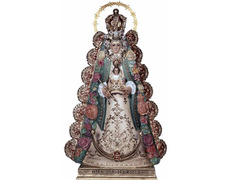
Ref: 2FM174N1

Ref: 2FA686N1

Ref: 2FA545N4
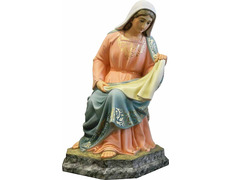
Ref: 2BA207VM

Ref: 2FA452

Ref: 2FR4780

Ref: 2FR200

Ref: 2FA221

Ref: 2FR401

Ref: 2FA424

Ref: 2FR14

Ref: 2FR497

Ref: 2FD135

Ref: 2FR501

Ref: 2FA473

Ref: 2FA472N4

Ref: 2FA29N1

Ref: 2FA537A12

Ref: 2FA449

Ref: 2FA216

Ref: 2FR172

Ref: 2FR478

Ref: 2FM150

Ref: 2FA222

Ref: 2FA526

Ref: 2FR11

Ref: 2FA278

Ref: 2FR473

Ref: 2FR574

Ref: 2FR164

Ref: 2FA11
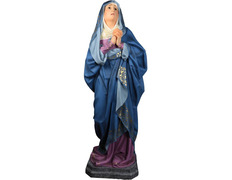
Ref: 2FA19N2-150
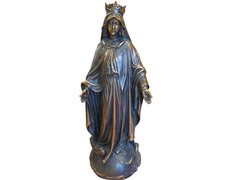
Ref: 2FR60BR

Ref: 2BR01N4

Ref: 2F0A4
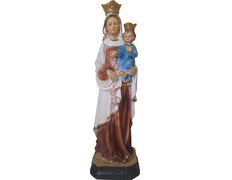
Ref: 92B1003CA
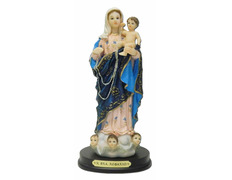
Ref: 59B3926
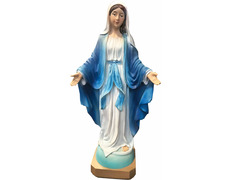
Ref: 92B1002MI
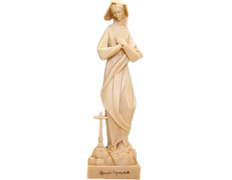
Ref: 9BV002

Ref: 2FA459

Ref: 2FR184A12